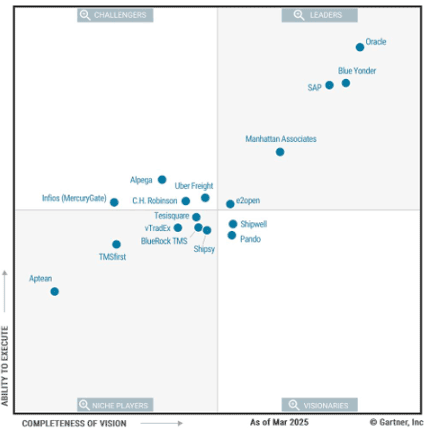Gilmore Says.... |
 |
Johns said TMS remains a hot space, with companies looking to achieve freight cost optimization (of course), improve visibility, replace aging legacy systems and achieve process improvements from a technology refresh.
|
 |
What do you say? |
|
| Click here to send us your comments |
| |
|
|
|
I also summarized the opening day Gartner keynote from analyst Ken Chadwick, who talked about the need to harness the power of record levels of change in the supply chain (which Chadwick called “divergence”), to gain competitive advantage.
It was well delivered, humorous at times, but I felt the call to action – greatly simplified, build out advanced visibility and more aggressive use of scenario planning – seemed a little bit like old news, or at least lacked the inspirational quotient one would expect from a Gartner keynote.
But whatever I think, the numbers in terms of attendees and Gartner trade show exhibitors indicate that the company has a winning strategy for this event, even as it now costs a substantial $5200 to attend, if you aren’t lucky enough to have a contract that includes a conference pass or two.
The conference has an ever-growing number of breakout sessions, a large portion of which are vendor-sponsored sessions, in which for a princely sum they can present a point of view, a product, or a case study.
Nothing the matter with that, but as I've also said before, you just have to look closely and know whether a session is vendor sponsored or not before you commit.
Likely due to the overall increase in breakouts, for the third year in a row Gartner cut the regular breakouts down to just 30 minutes (vs 45 in the past).
There is some goodness in these shorter sessions for sure, but some felt rushed, and none of the ones I attended had any time left for questions.
I attended a number of breakout sessions at the show and will summarize a couple of them here, both based on the famous “Magic Quadrant” approach Gartner uses to rank technology and services vendors along two dimensions (vision and ability to execute) and then place them in one of four quadrants, including the coveted leadership space.
Gartner’s Brock John’s led a session on the MQ for Transportation Management Systems (TMS).
Johns said TMS remains a hot space, with companies looking to achieve freight cost optimization (of course), improve visibility, replace aging legacy systems and achieve process improvements from a technology refresh.
Where are TMS vendors investing? Three main areas, Johns said: use of AI, support for sustainability initiatives (dashboards/analytics) and an improved user experience.
So let’s get right to the 2025 TMS MQ itself s shown below, which includes five in the leadership quadrant:
2025 Gartner TMS Magic Quadrant

Source: Gartner
My friend Dwight Klappich led a similar effort on the 2025 MQ for Warehouse Management Systems (WMS). He started by saying something provocative, that the largely incremental improvements in WMS capabilities over many years are soon to be supplanted with “transformational” advances, led of course by use of AI.
Klappich noted that you can get WMS from many different types of vendors: ERP vendors, “mega suite” vendors that offer WMS but a lot more (Labor Management, Order Management, more), WMS-focused providers, and WMS from materials handling system companies.
Klappich said there are a lot of frustrations among WMS adopters, which include:
• High costs for implementation
• Long implementations
• Solution complexity
• Weak decision support
• Integration challenges
• Inflexibility
Those are all valid issues, in my opinion.
So let’s again get right to the MQ. The leaders again this year were: Manhattan Associates, Blue Yonder, SAP, Oracle, Infor and Infios (formerly Korber).
Good sessions as usual by Johns and Klappich.
Think I will leave it there. I attended many other sessions and will be back with a part 3 next week.
What is your reaction to this review of Gartner 2025? What would you add? Let us know your thoughts at the Feedback section below.
Your Comments/Feedback
|